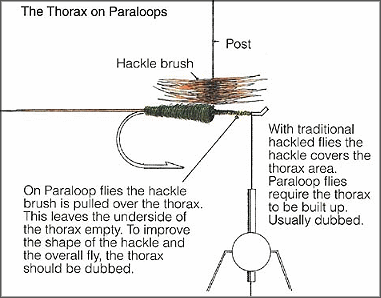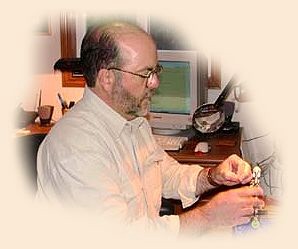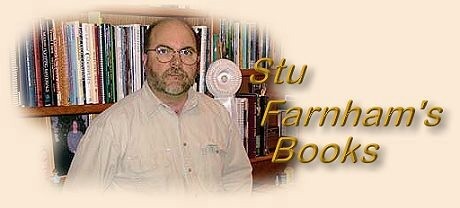|
The Internet is a powerful resource. It provides us instant
access to information, and brings us together via email,
bulletin boards, chat rooms, and instant messaging. FAOL
is a wonderful example of the Internet at its best. The Internet,
however, will never replace the printed page.
I've loved books and fishing since my youngest years, although
I did not start fly fishing until 1993. This column will give
me an opportunity to share reviews of some of my favorite fly
fishing and tying books (and some that are not such favorites)
with my friends here at FAOL. My library reflects my tastes
and interests, and so will this column. It will be heavily
slanted towards cold water fishing and tying for trout and
steelhead, and won't touch much on areas of which I know little,
such as warm or salt water fishing.
I hope that these reviews will motivate some of you to pick up
a good book, on this or any subject, and read.
~ Stu Farnham
Tying Flies the Paraloop Way
 Tying Flies the Paraloop Way
Tying Flies the Paraloop Way
Ian Moutter
Hardcover: 191 pages (April 2002)
Publisher: Countryman Press
ISBN: 0881505544
For the last nine years my home waters have been the
stretch of Oregon's Deschutes River between Warm Springs
and Trout Creek. The Deschutes is famous for its spring
salmonfly hatch, as well as for hosting a summer steelhead
run alongside a native strain of feisty rainbow trout known
locally as redsides. The fame of the river, along with its
proximity to the city of Portland, brings heavy fishing
pressure to the river.
As a result of that pressure, Deschutes redsides tend to be
wary fish, growing more wary as the season progresses. That
wariness has led me to favor flies that present different
profiles from the usual parachutes, comparaduns, and elk
hair caddises. Look into my flyboxes and you'll find funnelduns,
dancing caddis, and paraloop flies along with more standard fare.

The paraloop style of tying evolved at more or less the same
time in several places. At the same time that U.K. tier Ian
Moutter was experimenting with the paraloop style, Californian
Bill Quigley was inventing his hackle stacker dun and, Jim Cramer
and Ned Long were using similar patterns in their tying. Moutter's
Tying Flies the Paraloop Way describes the evolution of his
variant of the style.
The dominant feature of a paraloop fly is the wing. After
constructing a body using whatever method and material the
tier prefers, hackle is wrapped around an upright post in
a manner similar (but not identical) to wrapping a parachute
hackle. A robust thorax is added, and the hackle-wrapped post
is pulled down and forward over the thorax. The resulting
profile suggests both splayed legs and fluttering wings
above the thorax.

When I first received Moutter's book, I wondered if a single
style of tying could fill an entire volume. The answer, in
this case, is yes. Moutter provides basic information on
techniques tying paraloops, followed by specific applications
for traditional dry flies, emergers, buzzers (midges here in
the US), and spent wing patterns. He also acknowledges the
ork of Long, Cramer, et al in a chapter titled "The Paraloop
in the Hands of Others". Ian closes the book with a gallery
of paraloop patterns including several innovative applications
of the technique.
Overall, this is a good book that will allow you to add another
style to your tying arsenal. My only complaint is that the
chapters on tools and materials contain very little that is
either new or directly related to the tying of paraloop flies.
Moutter will send you rummaging through your box of little
used tying equipment to find that gallows tool you bought
but never use. You learned to tie parachutes without it, but,
believe me, you can't tie a paraloop without one.
~ Stu Farnham
About Stu
 Stu Farnham is a New Englander by birth, who was transplanted to
and put down roots in Oregon in the early 1990s, now residing in
the Seattle area. A software engineering manager by vocation,
he can be found in his spare time chasing trout and steelhead
in the rivers of the Pacific Northwest, chasing his four Gordon
Setters (who in turn are chasing chukar), tying flies, reading,
or working on his website. Colleen, his long suffering wife of
28 years, is a professionally trained personal chef.
Stu Farnham is a New Englander by birth, who was transplanted to
and put down roots in Oregon in the early 1990s, now residing in
the Seattle area. A software engineering manager by vocation,
he can be found in his spare time chasing trout and steelhead
in the rivers of the Pacific Northwest, chasing his four Gordon
Setters (who in turn are chasing chukar), tying flies, reading,
or working on his website. Colleen, his long suffering wife of
28 years, is a professionally trained personal chef.
|

 Tying Flies the Paraloop Way
Tying Flies the Paraloop Way
 Stu Farnham is a New Englander by birth, who was transplanted to
and put down roots in Oregon in the early 1990s, now residing in
the Seattle area. A software engineering manager by vocation,
he can be found in his spare time chasing trout and steelhead
in the rivers of the Pacific Northwest, chasing his four Gordon
Setters (who in turn are chasing chukar), tying flies, reading,
or working on his website. Colleen, his long suffering wife of
28 years, is a professionally trained personal chef.
Stu Farnham is a New Englander by birth, who was transplanted to
and put down roots in Oregon in the early 1990s, now residing in
the Seattle area. A software engineering manager by vocation,
he can be found in his spare time chasing trout and steelhead
in the rivers of the Pacific Northwest, chasing his four Gordon
Setters (who in turn are chasing chukar), tying flies, reading,
or working on his website. Colleen, his long suffering wife of
28 years, is a professionally trained personal chef.
